150. Fire suppression by humans
A) can change the species
composition within biological communities.
B) will result
ultimately in sustainable production of increased amounts of forest
products for human use.
C) is necessary for the protection of
threatened and endangered forest species.
D) is a management
goal of conservation biologists to maintain the healthy condition of
forest communities.
A) can change the species composition within biological communities
151. Which of the following statements best describes the interaction
between fire and ecosystems?
A) The likelihood of a wildfire
occurring in a given ecosystem is highly predictable over the short
term.
B) Many kinds of plants and plant communities have adapted
to frequent fires.
C) The suppression of forest fires by man has
prevented certain communities, such as grasslands, from reaching their
climax stage.
D) Chaparral communities have evolved to the
extent that they rarely burn.
B) Many kinds of plants and plant communities have adapted to frequent fires.
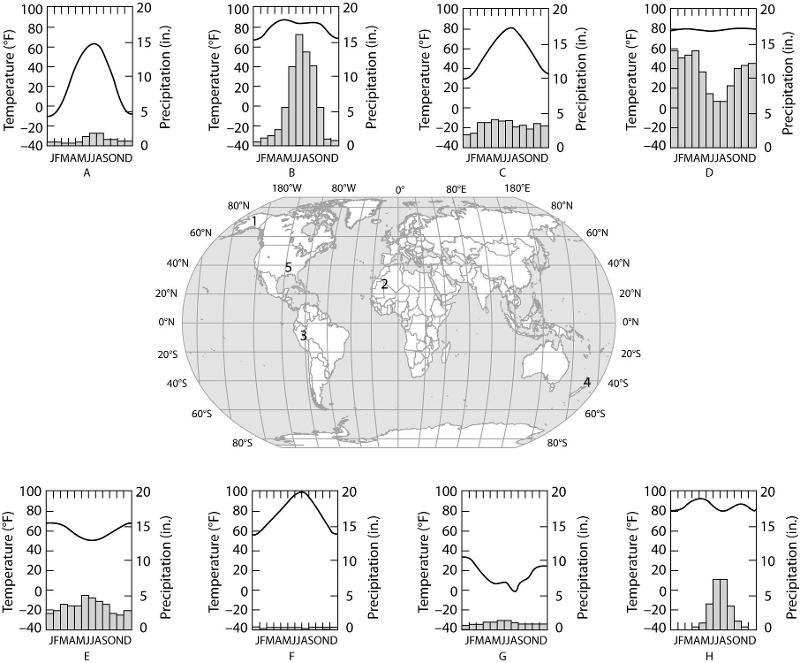
152. Which climograph shows the climate for location 1?
A) A
B) C
C) E
D) H
A) A
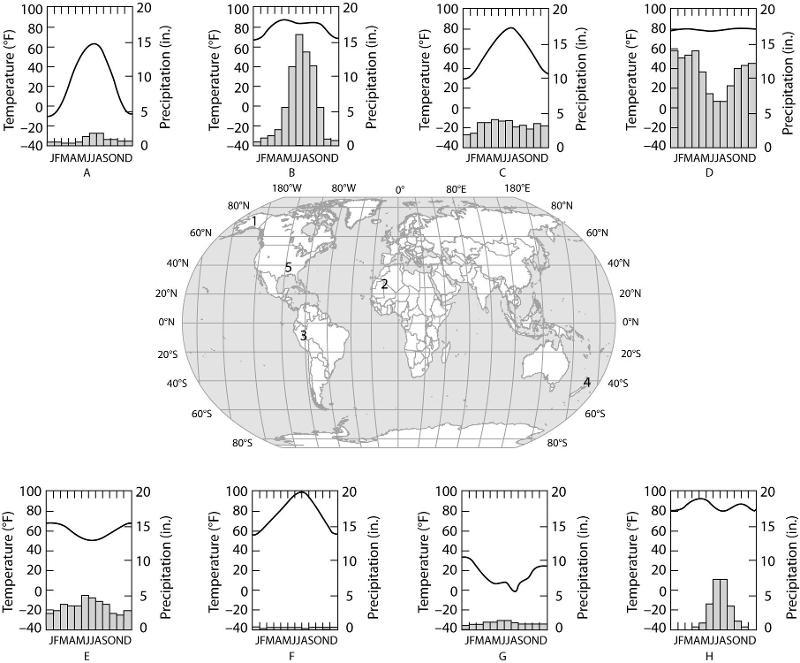
153. Which climograph shows the climate for location 2?
A)
C
B) D
C) F
D) H
C) F
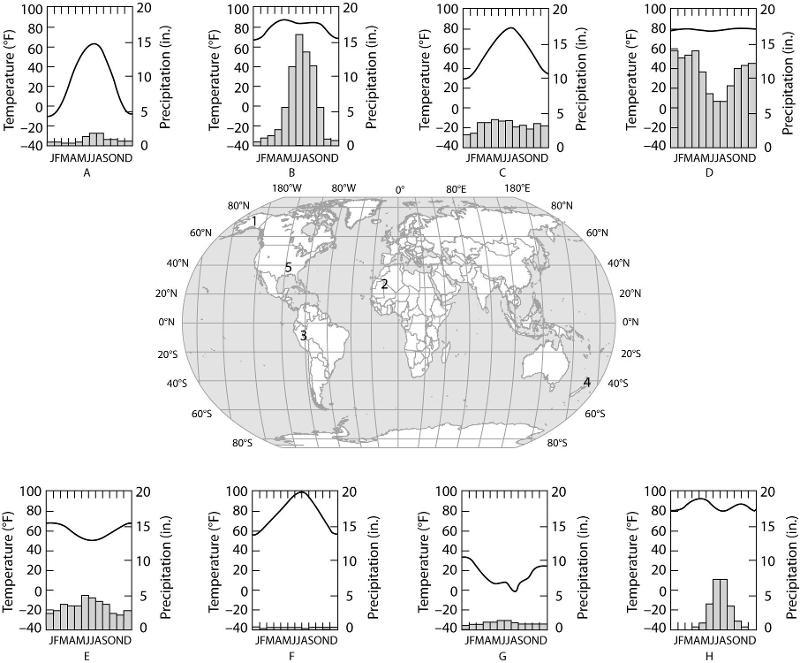
154. Which climograph shows the climate for location 3?
A) B
B) C
C) D
D) E
C) D
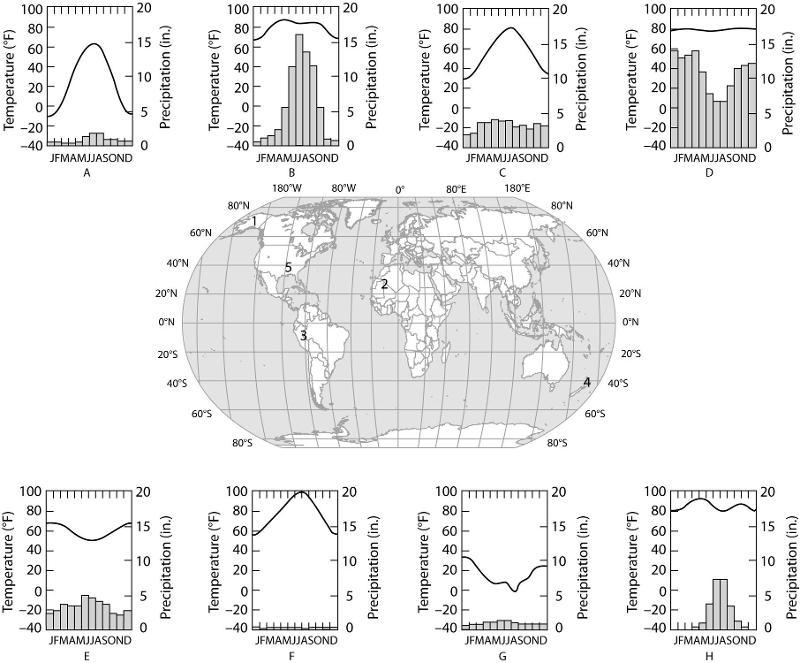
155. Which climograph shows the climate for location 4?
A) A
B) B
C) E
D) G
C) E
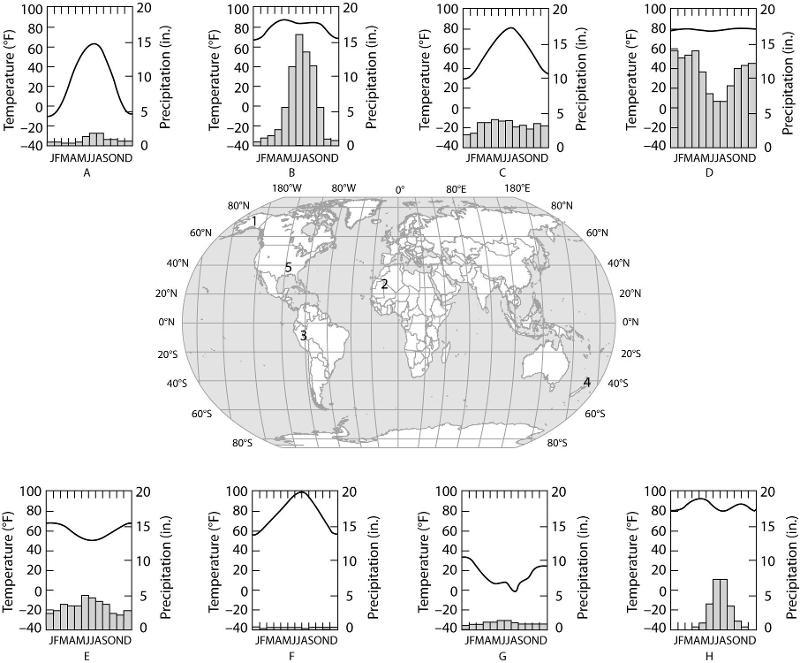
156. Which climograph shows the climate for location 5?
A) A
B) C
C) D
D) H
B) C
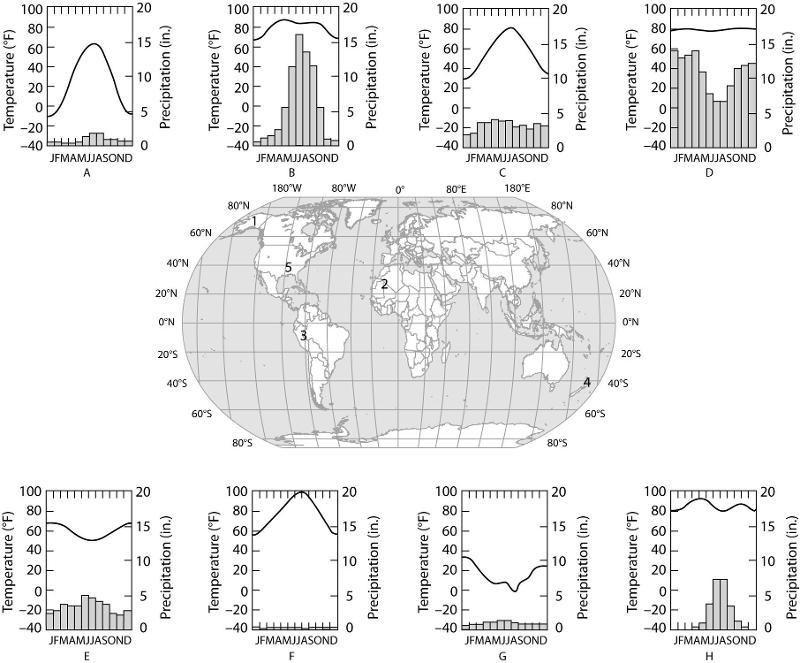
157. Which of the following best substantiates why location 3 is an
equatorial (tropical) climate?
A) It has a monsoon season during
the winter months.
B) The temperature is high for each monthly
average.
C) The temperatures reach 100°F during some months.
D) The temperatures are lower in June, July, and August.
B) The temperature is high for each monthly average.
158. In areas of permafrost, stands of black spruce are frequently
observed in the landscape, while other tree species are noticeably
absent. Often these stands are referred to as "drunken
forests" because many of the black spruce are displaced from
their normal vertical alignment.
What might be the
adaptive significance of these unusual forests growing the way they
do in this marginal habitat?
A) Branches are adapted to
absorb more CO₂ with this displaced alignment.
B) Taproot
formation is impossible, so trees developed shallow root beds.
C) Trees are tilted so snow prevents them from breaking or
tipping over.
D) Trees tip so that they do not compete with
each other for sunlight.
B) Taproot formation is impossible, so trees developed shallow root beds.
159. Which of the following is an important feature of most terrestrial biomes?
A) annual average rainfall in excess of 250 cm
B) a
distribution predicted almost entirely by rock and soil patterns
C) clear boundaries between adjacent biomes
D) vegetation
demonstrating vertical layering
D) vegetation demonstrating vertical layering
160. Suppose that the number of bird species is determined mainly by
the number of vertical strata found in the environment. If so, in
which of the following biomes would you find the greatest number of
bird species?
A) tropical rain forest
B) savanna
C)
temperate broadleaf forest
D) temperate grassland
A) tropical rain forest
161. Two plant species live in the same biome but on different
continents. Although the two species are not at all closely related,
they may appear quite similar as a result of
A)
convergent evolution.
B) allopatric speciation.
C)
introgression.
D) gene flow.
A) convergent evolution.
162. In the figure above, which number would designate the arctic
tundra biome?
A) 2
B) 3
C) 4
D) 5
D) 5
163. In the figure above, which number would designate the biome with the highest variation in annual precipitation?
A) 1
B) 2
C) 3
D) 4
A) 1
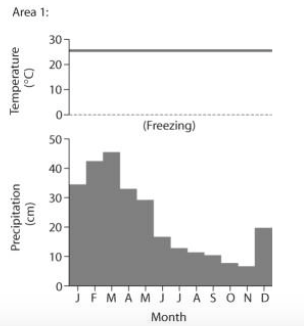
164. Based on the data in the figure above, which of the following statements is true?
A.Area 2 could be tundra.
B.Area 1 could be called a tropical
wet/rain forest.
C.Area 1 could be called a boreal
forest/taiga.
D.Area 2 could be called a temperate grassland.
B.Area 1 could be called a tropical wet/rain forest.
165. In deep water, which of the following abiotic factors would most limit productivity?
A.light availability
B.temperature
C.solute concentration
A.light availability
166. Wetlands are standing bodies of freshwater, just like lakes and ponds. However, wetlands are different from lakes and ponds because wetlands have _____.
A.emergent vegetation
B.oxygen-poor water
C.shallow water
and emergent vegetation
D.emergent vegetation and oxygen-poor water
C.shallow water and emergent vegetation
167. Which of the following statements regarding turnover in a lake is correct?
A.Fall turnovers and spring turnovers are exactly the
same.
B.The surface water gets to 4°C only by cooling.
C.In
fall turnover, dense water at 4°C rises and disturbs sediments in the
benthic zone.
D.In fall turnover, dense water at 4°C sinks and
disturbs sediments in the benthic zone.
D.In fall turnover, dense water at 4°C sinks and disturbs sediments in the benthic zone.
168. A fish swimming into an estuary from a river would have which of
the following as its greatest physiological challenge?
a. The change in water solute content would challenge the
osmotic balance of the fish.
b. The low oxygen content would
give the fish difficulty in swimming aerobically.
c. The
temperature change would stress the fish by denaturing its proteins.
d. The high water flow would make the fish expend more energy.
a. The change in water solute content would challenge the osmotic balance of the fish.
169. Which of the following types of organisms is likely to have the widest geographic distribution?
A.bears
B.songbirds
C.bacteria
D.lizards
C.bacteria
170. Which of the following can be said about light in aquatic environments?
A.Most photosynthetic organisms avoid the surface where the light
is too intense.
B.Light penetration seldom limits the
distribution of photosynthetic species.
C.Water selectively
reflects and absorbs certain wavelengths of light.
D.Longer
wavelengths penetrate to greater depths.
C.Water selectively reflects and absorbs certain wavelengths of light.
171. Turnover of water in temperate lakes during the spring and fall is made possible by which of the following?
A) warm, less dense water layered at the top
B) cold, more
dense water layered at the bottom
C) a distinct thermocline
between less dense warm water and cold, dense water
D) the
changes in the density of water as seasonal temperatures change
D) the changes in the density of water as seasonal temperatures change
172. Imagine that a deep temperate zone lake did not "turn over" during the spring and fall seasons. Based on the physical and biological properties of limnetic ecosystems, what would be the difference from normal seasonal turnover?
A) The lake would fail to freeze over in winter.
B) An algal
bloom of algae would result every spring.
C) Lakes would suffer
a nutrient depletion in surface layers.
D) The pH of the lake
would become increasingly alkaline.
C) Lakes would suffer a nutrient depletion in surface layers.
173. If you are interested in observing a relatively simple community
structure in a clear water lake, you would do well to choose diving
into
A) an oligotrophic lake.
B) a eutrophic lake.
C) a relatively shallow lake.
D) a nutrient-rich lake.
A) an oligotrophic lake.
174. If a meteor impact or volcanic eruption injected a lot of dust
into the atmosphere and reduced the sunlight reaching Earth's surface
by 70% for one year, which of the following marine communities most
likely would be least affected?
A) deep-sea vent
B) coral
reef
C) intertidal
D) estuary
A) deep-sea vent
175. The oceans affects the biosphere by ____.
I) producing a
substantial amount of the biosphere's oxygen
II) adding carbon
dioxide to the atmosphere
III) being the source of most of
Earth's rainfall
IV) regulating the pH of freshwater biomes and
terrestrial groundwater
A) only I and III
B) only I, II, and III
C) only I,
II, and IV
D) only II and IV
A) only I and III
176. A fish species known for its success in the aphotic zone may have which of the following characteristics?
I) symbioses with photosynthetic organisms
II) highly developed
chemoreception
III) adaptations for burrowing
IV)
adaptations for sit and wait predation
A) only II, III, and IV
B) only I and III
C) only I, II
and III
D) only I, II, and IV
A) only II, III, and IV
177. Which of the following is responsible for the differences in
summer and winter temperature stratification of deep temperate zone
lakes?
A) Water is densest at 4°C.
B) Oxygen is most
abundant in deeper waters.
C) Winter ice sinks in the summer.
D) Stratification is caused by a thermocline.
A) Water is densest at 4°C.
178. A certain species of pine tree survives only in scattered
locations at elevations above 2,800 m in the western United States. To
understand why this tree grows only in these specific places, an
ecologist should
A) study the anatomy and physiology of this
species.
B) investigate the various biotic and abiotic factors
that are unique to high altitude.
C) analyze the soils found in
the vicinity of these trees, looking for unique chemicals that may
support their growth.
D) collect data on temperature, wind, and
precipitation at several of these locations for a year.
B) investigate the various biotic and abiotic factors that are unique to high altitude.
179. Which of the following statements best describes the effect of
climate on biome distribution?
A) Average annual temperature and
precipitation are sufficient to predict which biome will be found in
an area.
B) Seasonal fluctuation of temperature is not a
limiting factor in biome distribution if areas have the same annual
temperature and precipitation means.
C) The average climate and
pattern of climate are important in determining biome
distribution
D) Correlation of climate with biome distribution is
sufficient to determine the cause of biome patterns.
C) The average climate and pattern of climate are important in determining biome distribution
180. In the development of terrestrial biomes, which factor is most
dependent on all the others?
A) the species of colonizing
animals
B) prevailing rainfall
C) mineral nutrient
availability
D) soil structure
A) the species of colonizing animals
181. Studying species transplants is a way that ecologists
A) determine the distribution of a species in a specified area.
B) develop mathematical models for distribution and abundance of
organisms.
C) determine if dispersal is a key factor in limiting
distribution of organisms.
D) consolidate a landscape region
into a single ecosystem.
C) determine if dispersal is a key factor in limiting distribution of organisms.
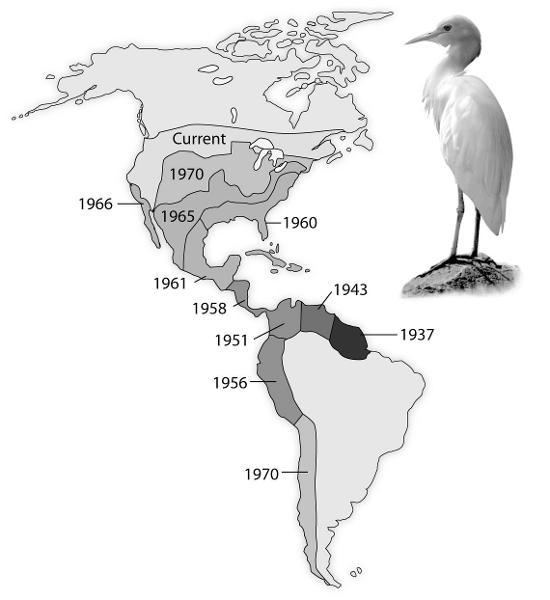
182. The range of cattle egrets has expanded between 1937 and today. How would an ecologist likely explain the expansion of the cattle egret?
A) the first egrets to colonize South America evolved into a new
species capable of competing with the native species of herons and
egrets
B) A habitat left unoccupied by native herons and egrets
met the biotic and abiotic requirements of the cattle egret
transplants and their descendants
C) There are no predators for
cattle egrets in the New World, so they continue to expand their
range
D) Climate factors, such as temperature and precipitation,
provide a suitable habitat for cattle egrets
B) A habitat left unoccupied by native herons and egrets met the biotic and abiotic requirements of the cattle egret
183. Which statements about dispersal are correct?
I) Dispersal
is a common component of the life cycles of plants and animals
II) Colonization of devastated areas after floods or volcanic
eruptions primary depends upon climate
III) Seeds are important
dispersal stages in the life cycle of most flowering plants
IV)
Dispersal occurs only on an evolutionary time scale
A) only I and III
B) only I, II, and IV
C) only II and
IV
D) only II, III, and IV
A) only I and III
184. Which of the following examples of an ecological effect leading
to an evolutionary effect is most correct?
A) When seeds are not
plentiful, trees produce more seeds.
B) A few individuals with
denser fur survive the coldest days of an ice age, and the reproducing
survivors of the ice age all have long fur.
C) Fish that swim
the fastest in running water catch the most prey and more easily
escape predation.
D) The insects that spend the most time
exposed to sunlight have the most mutations.
B) A few individuals with denser fur survive the coldest days of an ice age, and the reproducing survivors of the ice age all have long fur.
185. If carbon dioxide levels continue to increase and climate change continues over the next century, which of the following would best predict the directional migration of the North American ecosystems from the biomes shown in this climograph?
A.The ecosystems will shift to the south due to decreasing
transpiration rates.
B.The ecosystems will move down mountains as
the temperatures warm.
C.The ecosystems will move to both the
eastern and western coastlines as these areas will be more
moderate.
D.The ecosystems will shift to the north as
temperatures warm.
D.The ecosystems will shift to the north as temperatures warm.
186. To maintain homeostasis freshwater fish must _____.
A) excrete large quantities of electrolytes
B) consume
large quantities of water
C) excrete large quantities of
water
D) take in electrolytes through simple diffusion
C) excrete large quantities of water
187. Single-celled Paramecium live in pond water (a hypotonic
environment). They have a structural feature, a contractile vacuole,
which enables them to osmoregulate. If you observed them in the
following solutions, at which sucrose concentration (in millimolars,
mM) would you expect the contractile vacuole to be most active?
A) 0.0 mM sucrose
B) 0.05 mM saline
C) 0.08 mM
sucrose
D) 1.0 mM saline
A) 0.0 mM sucrose
188. Sharks live in seawater. Their tissues are isotonic to seawater,
but their concentrations of sodium ions, potassium ions, and chloride
ions in cells and extracellular fluids are similar to those of
freshwater fishes. How is that possible?
A) Urea and trimethylamine oxide contribute to intra- and
extracellular osmolarity in shark tissues.
B) Metabolic
intermediates of sharks tie up intracellular chloride and potassium
ions.
C) Their blood is hypotonic to their tissues.
D) They
excrete large quantities of electrolytes.
A) Urea and trimethylamine oxide contribute to intra- and extracellular osmolarity in shark tissues.
189. Hagfish (Eptatretus cirrhauts) are a jawless marine vertebrate
that are isotonic with their environment and are considered to be
osmoconformers. How might this interesting adaptation limit the
habitat that the hagfish can tolerate?
A) Hagfish are not limited by salinity.
B) Osmoconformers
do not face the same pressures as osmoregulators and can live in any
marine environment.
C) Individual hagfish will adapt to different
salinities over their lifetime and, therefore, can inhabit any marine
environment.
D) Hagfish habitat is limited by the salinity of the environment.
D) Hagfish habitat is limited by the salinity of the environment.
190. Tissues of sharks are isotonic to seawater, but their
concentrations of sodium ions, potassium ions, and chloride ions in
cells and extracellular fluids are similar to those of freshwater
fishes. What can you infer about the movement of sodium and chloride
in these animals?
A) To maintain homeostasis of sodium and chloride levels, the
shark must take up additional sodium and chloride from
seawater.
B) Sodium and chloride will diffuse into shark gills
from seawater down their concentration gradient.
C) Sharks
conserve sodium and chloride, limiting excretion.
D) Sodium and
chloride must be eliminated through the gills.
B) Sodium and chloride will diffuse into shark gills from seawater down their concentration gradient.
191. What role do chloride cells play in osmoregulation of marine
fish with bony skeletons?
A) They actively transport chloride into the gills.
B) They
mediate the movement of salt from seawater through their
gills.
C) They are involved in excretion of excess salt.
D)
They actively transport salt across the basolateral membrane of the
rectal gland.
C) They are involved in excretion of excess salt.
192. Salmon eggs hatch in freshwater. The fish then migrate to the
ocean (a hypertonic solution) and, after several years of feeding and
growing, return to freshwater to breed. How can these organisms make
the transition from freshwater to ocean water and back to freshwater?
A) The rectal gland functions in the ocean water, and chloride
cells function in freshwater.
B) Different gill cells are
involved in osmoregulation in freshwater than in salt water.
C)
Salmon in freshwater excrete dilute urine, and salmon in salt water
secrete concentrated urine.
D) Their metabolism changes in salt
water to degrade electrolytes.
B) Different gill cells are involved in osmoregulation in freshwater than in salt water.
193. Terrestrial organisms lose water through evaporation. In what
ecosystem might an entomologist find a good study organism to examine
the prevention of water loss?
A) wet rain forest
B) desert
C) prairie
D) chaparral
B) desert
194. A necropsy (postmortem analysis) of a marine sea star that died
after it was mistakenly placed in fresh water would likely show that
it died because _____.
A) it was stressed and needed more time to acclimate to the new
conditions
B) it was so hypertonic to the fresh water that it
could not osmoregulate
C) its contractile vacuoles
ruptured
D) its cells dehydrated and lost the ability to metabolize
B) it was so hypertonic to the fresh water that it could not osmoregulate
195. The body fluids of an osmoconformer would be _____ with its
_____ environment
A) isoosmotic; freshwater
B) hyperosmotic;
saltwater
C) isoosmotic; saltwater
D) hypoosmotic; saltwater
C) isoosmotic; saltwater
196. Compared to the seawater around them, most
marine invertebrates are _____.
A) hyperosmotic
B) hypoosmotic
C) isoosmotic
D)
hyperosmotic and isoosmotic
C) isoosmotic
197. The fluid with the highest osmolarity is _____.
A) distilled water
B) plasma in birds
C) plasma in
mammals
D) seawater in a tidal pool
D) seawater in a tidal pool
198. A human who has no access to fresh water but is forced to drink
seawater instead will _____.
A) thrive under such conditions, as long as he has lived at the
ocean most of his life
B) excrete more water molecules than taken
in, because of the high load of ion ingestion
C) develop
structural changes in the kidneys to accommodate the salt
overload
D) risk becoming overhydrated within twelve hours
B) excrete more water molecules than taken in, because of the high load of ion ingestion
199. Unlike most bony fishes, sharks maintain body fluids that are
isoosmotic to seawater, so they are considered by many to be
osmoconformers. Nonetheless, these sharks osmoregulate at least
partially by _____.
A) using their gills and kidneys to rid themselves of sea
salts
B) monitoring dehydration at the cellular level with
special gated aquaporins
C) tolerating high urea concentrations
that are balanced with internal salt concentrations to seawater
osmolarity
D) synthesizing trimethylamine oxide, a chemical that
binds and precipitates salts inside cells
C) tolerating high urea concentrations that are balanced with internal salt concentrations to seawater osmolarity
200. The necropsy (postmortem analysis) of a freshwater fish that
died after being placed accidentally in saltwater would likely show
that _____.
A) loss of water by osmosis from cells in vital organs resulted
in cell death and organ failure
B) high amounts of salt had
diffused into the fish's cells, causing them to swell and lyse
C)
the kidneys were not able to keep up with the water removal necessary
in this hyperosmotic environment, creating an irrevocable loss of
homeostasis
D) the gills became encrusted with salt, resulting in
inadequate gas exchange and a resulting asphyxiation
A) loss of water by osmosis from cells in vital organs resulted in cell death and organ failure